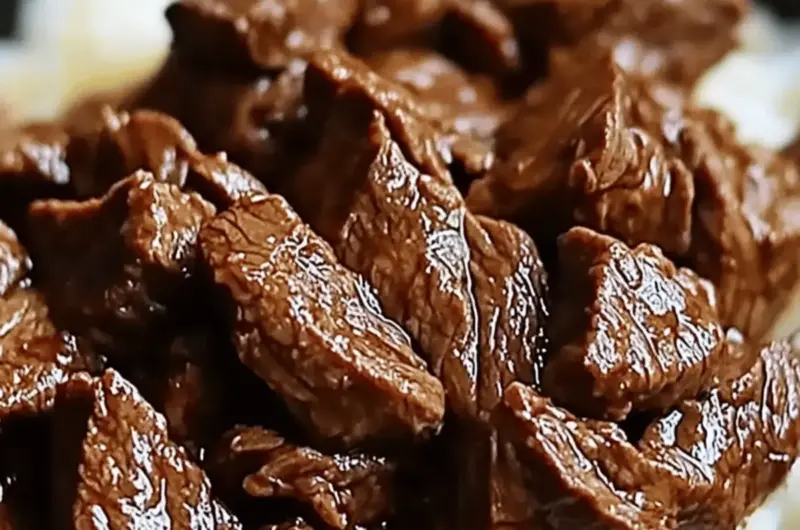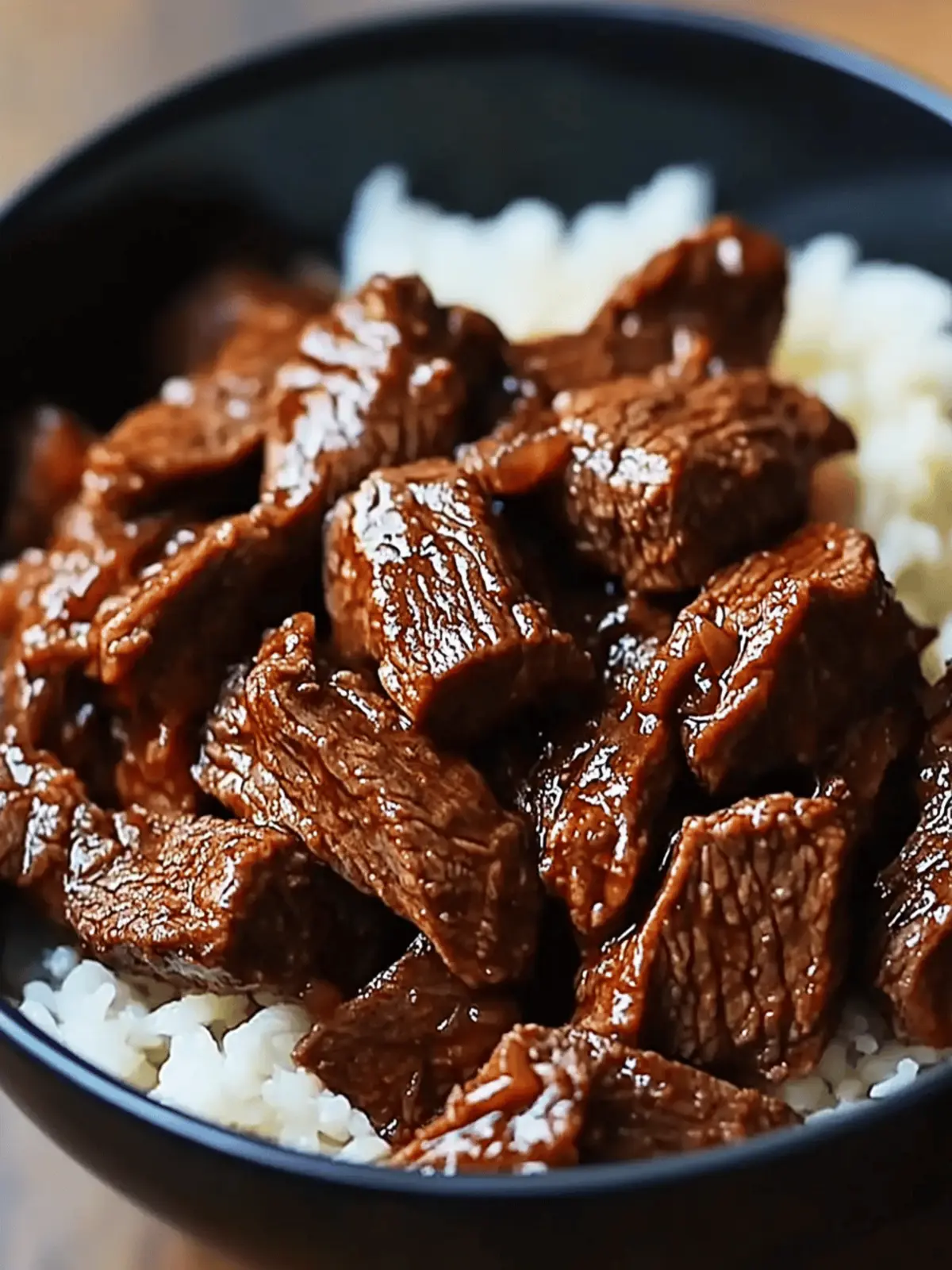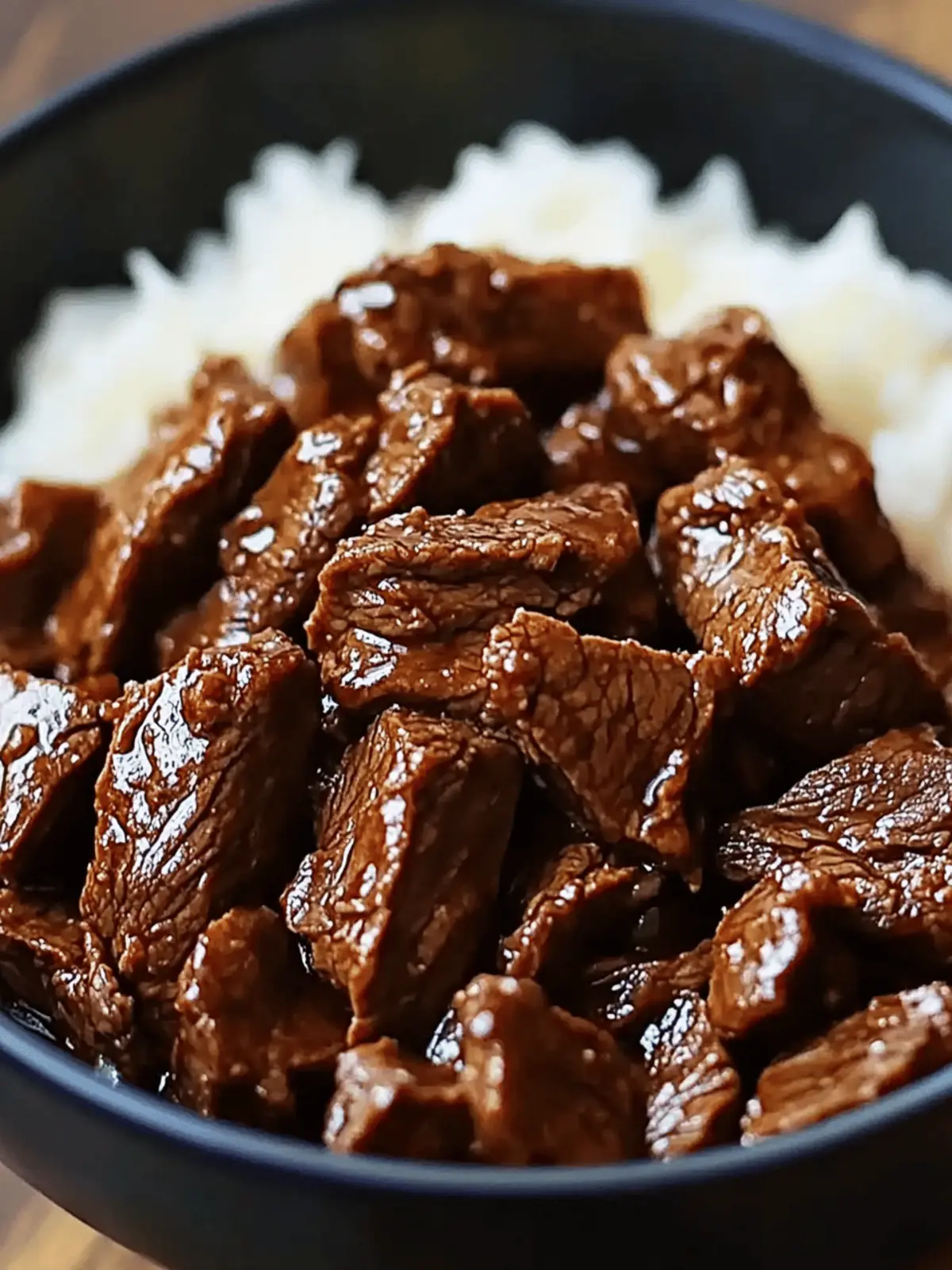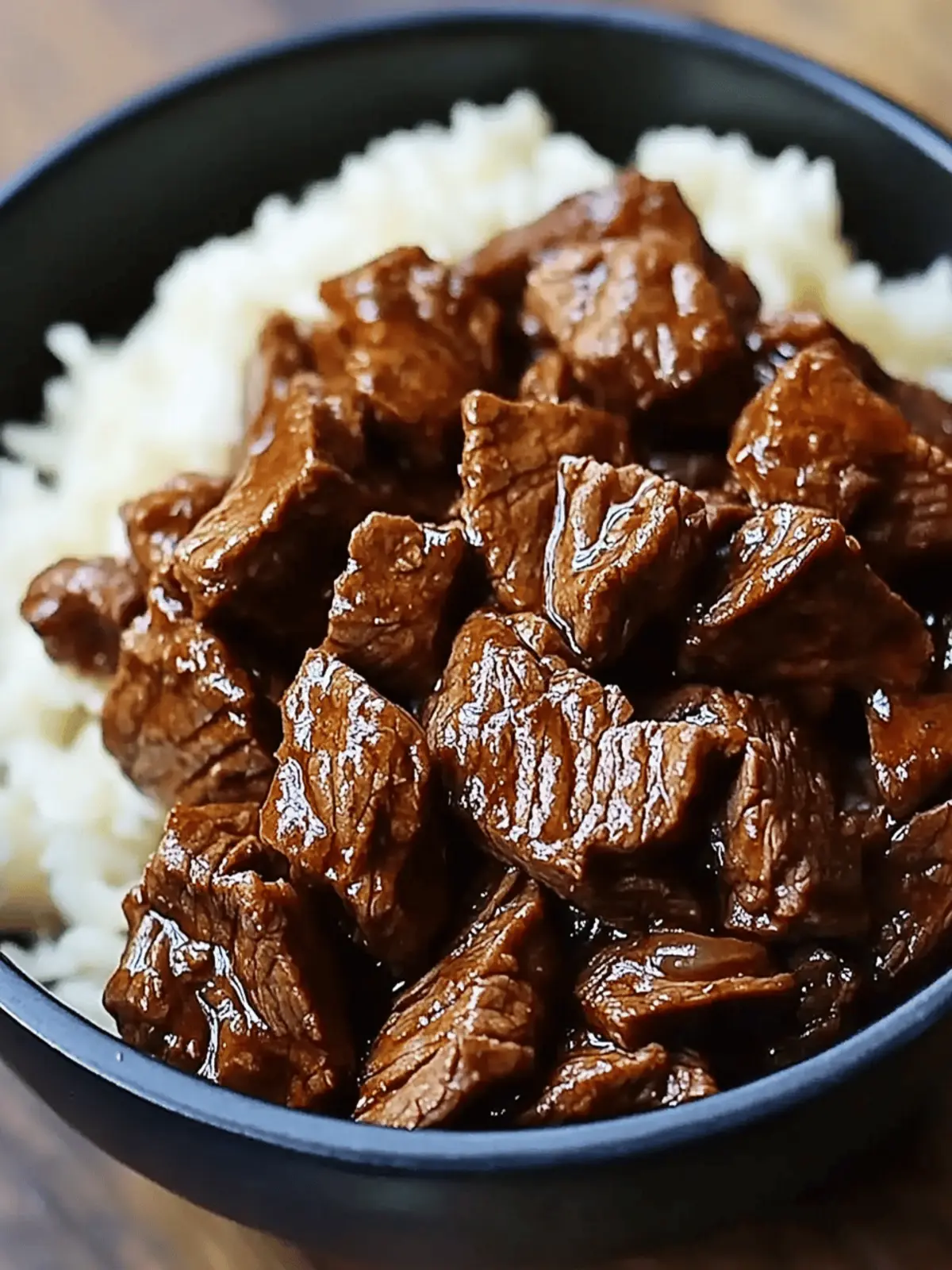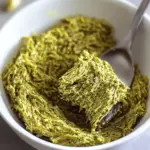The moment the slow cooker’s lid lifts, a wave of savory aromas floods the kitchen, mingling garlic, ginger, and the warm notes of soy sauce into the air. It’s a delightful reminder of a comforting Korean barbecue feast, but the best part? You’ve done it all with minimal effort. This Easy Slow Cooker Korean Beef is a revelation for anyone weary of fast food and looking to savor homemade goodness that melts in your mouth. Perfectly tender chunks of beef simmer away in a luscious sauce that harmonizes sweet and savory notes, making it an instant favorite for family dinners or meal prep days.
As seasons change and days get busier, there’s an undeniable charm in being able to set a few simple ingredients in your slow cooker and let them transform into a delightful culinary experience. Whether you’re a seasoned chef or just dipping your toes into home cooking, this dish welcomes you to create something spectacular without the fuss. Plus, it’s adaptable—swap out the beef for chicken, pork, or even tofu, ensuring everyone at the table leaves satisfied. Let’s dive in and rediscover the joy of cooking!
Why is Slow Cooker Korean Beef a Must-Try?
Ease of Preparation: Just toss everything into the slow cooker and let it work its magic while you go about your day.
Rich, Complex Flavors: The combination of garlic, ginger, and soy sauce creates an explosion of taste that will leave your taste buds craving more.
Versatile Customization: Substitute beef with chicken, pork, or even tofu for a personalized twist.
Meal Prep Friendly: Perfect for making ahead; this dish stores well, ensuring you’ve got satisfying meals ready when you need them.
Crowd-Pleasing Delight: Guests will be impressed by your culinary skills, but you’ll know how easy it was to achieve!
Rediscover the joy of cooking while enjoying leftover evening meals by checking out our tips on meal prep.
Slow Cooker Korean Beef Ingredients
• Get ready to savor homemade goodness with these simple staples!
For the Beef
- Chuck Beef – Main protein, provides a rich flavor; substitute with chicken, pork, or tofu for variations.
For the Aromatics
- Onion – Adds sweetness and depth; use yellow or white onion for best results.
- Garlic (3 tsp, crushed) – Builds the aromatic base; fresh garlic is preferred for optimal flavor.
- Ginger (2 tsp, minced) – Enhances warmth and complexity; fresh ginger provides a more robust flavor than powdered.
For the Sauce
- Rice Wine Vinegar (1 tbsp) – Brightens the dish; can be swapped with apple cider vinegar if unavailable.
- Sesame Oil (2 tbsp) – Adds nutty flavor; use toasted sesame oil for a stronger taste.
- Soy Sauce (½ cup) – Provides umami depth; choose low-sodium for a health-conscious option.
- Beef Stock (½ cup) – Enhances moisture and richness; can replace with vegetable stock for a vegetarian version.
- Brown Sugar (½ cup) – Balances salty flavors with sweetness; maple syrup or coconut sugar are good alternatives.
- Red Chili Flakes (¼ tsp) – Introduces mild heat; adjust according to personal preference or substitute with gochujang for a spicier kick.
For Thickening the Sauce
- Cornstarch (3 tbsp) & Water (3 tbsp) – Helps thicken the sauce; ensure there are no lumps when mixing.
How to Make Slow Cooker Korean Beef
-
Combine Ingredients: In your slow cooker, mix together the onion, garlic, ginger, rice wine vinegar, sesame oil, soy sauce, beef stock, brown sugar, and red chili flakes. This aromatic blend sets the foundation for the dish.
-
Add the Beef: Gently place the chuck beef cubes into the sauce mixture, ensuring every piece is well-coated. This is crucial for maximum flavor as it cooks.
-
Cook Slowly: Cover and set the slow cooker to low. Let it simmer for 8 hours, or until the beef is tender and fragrant. Resist the urge to lift the lid during cooking!
-
Create a Slurry: In a small bowl, whisk the cornstarch and water until smooth, then stir this mixture back into the slow cooker. This step thickens the sauce and enhances its velvety texture.
-
Thicken the Sauce: Increase the heat to high and let it cook for an additional 30 minutes. The sauce should become rich and thick, clinging beautifully to the tender beef.
-
Serve and Enjoy: After cooking, serve the Slow Cooker Korean Beef hot. Garnish with sliced green onions and sesame seeds for an added touch of flavor and presentation.
Optional: Serve this dish over steamed white rice for a comforting meal.
Exact quantities are listed in the recipe card below.
Expert Tips for Slow Cooker Korean Beef
-
Choose the Right Cut: Opt for well-marbled chuck beef, as it ensures juicy, tender results. Avoid lean cuts to prevent dryness.
-
Layer Flavors: For a deeper taste, consider sautéing garlic and ginger before adding them to the slow cooker. This enhances the aromatic profile of your Slow Cooker Korean Beef.
-
Lid on, Always: Avoid lifting the lid during cooking! This keeps the heat consistent, promoting tender meat and a well-developed sauce.
-
Customize Wisely: Feel free to swap beef for chicken or tofu—but be mindful of cooking times, as they may vary. This keeps your dish exciting and caters to different dietary preferences.
-
Store with Care: When storing leftovers, ensure they are in an airtight container. Slow Cooker Korean Beef stays delicious for up to 4 days, making it perfect for meal prep!
How to Store and Freeze Slow Cooker Korean Beef
Fridge: Store leftovers in an airtight container for up to 4 days, ensuring you retain the mouthwatering flavors of your Slow Cooker Korean Beef.
Freezer: For longer storage, freeze in a freezer-safe container for up to 3 months. To prevent freezer burn, consider wrapping it tightly in plastic wrap before placing it in a container.
Reheating: When ready to enjoy, thaw overnight in the fridge, then gently reheat on the stove or microwave, adding a splash of water or broth to keep it moist.
Meal Prep: Perfect for meal prep, Slow Cooker Korean Beef can easily be portioned into single servings for quick and satisfying weeknight dinners.
What to Serve with Slow Cooker Korean Beef?
Create a well-rounded meal that complements the savory richness of this comforting dish.
-
Steamed White Rice: The fluffy texture absorbs the flavorful sauce perfectly, making every bite satisfying and complete.
-
Cauliflower Rice: A lighter, low-carb alternative that provides a fresh crunch and fun texture, ideal for a healthier take.
-
Korean-Style Pickled Vegetables: These tangy, refreshing sides contrast beautifully with the rich flavors of the beef, adding a delightful zing.
-
Crispy Lettuce Wraps: Wrap the beef in crunchy lettuce leaves for a fun and interactive meal that balances textures and flavors.
-
Savory Miso Soup: A warm and soothing soup complements the beef, offering a delicate umami flavor that echoes its depth.
-
Grilled Zucchini: Lightly charred, the zucchini adds a smokiness that pairs beautifully with the sweet and savory notes of the beef.
-
Sesame Noodles: Tossed in a light soy sauce dressing, these noodles bring a delightful chewiness that complements the tender beef and makes for a satisfying bite.
Enjoy your meal with a Korean fruit punch or a refreshing green tea to cleanse the palate and enhance your dining experience!
Slow Cooker Korean Beef Variations
Embrace your creativity and make this recipe your own with these fun and flavorful twists!
-
Chicken Swap: Use chicken breast or thighs for a leaner option; adjust cooking time as necessary to avoid dryness.
-
Tofu Alternative: For a vegetarian delight, swap beef for marinated tofu, soaking up all those delicious flavors beautifully.
-
Porky Variation: Pork shoulder can be substituted for a different but equally savory taste; adjust the seasoning slightly for balance.
-
Quinoa Boost: Serve over fluffy quinoa instead of rice for a fantastic grain alternative packed with protein; it’s nutty and satisfying.
-
Lettuce Wraps: For a fresh, crunchy experience, use crisp lettuce leaves as wraps, adding a zing with fresh herbs and a squeeze of lime.
-
Spicy Kick: Enhance heat levels by mixing in gochujang or sriracha to the sauce before cooking for an exciting rise in spice.
-
Add Veggies: Toss in vegetables like carrots and bell peppers towards the last hour of cooking for a colorful and wholesome blend.
-
Sesame Crunch: Top with toasted sesame seeds and chopped scallions for delightful texture and extra flavor in every bite.
Explore these variations and find your perfect rendition of Slow Cooker Korean Beef—it’s all about making it uniquely yours!
Make Ahead Options
These Slow Cooker Korean Beef dishes are perfect for busy home cooks looking to save time during the week! You can prepare all the ingredients—onions, garlic, ginger, and the sauce—up to 24 hours in advance. Simply combine them in your slow cooker, cover, and refrigerate. The chuck beef can be cut and marinated in the sauce overnight for enhanced flavor, making the cooking process seamless. When you’re ready to serve, just add the beef, cook on low for 8 hours, and follow up with the cornstarch slurry to thicken the sauce. This way, you’ll enjoy rich, comforting flavors without the stress, and your meal will be just as delicious when ready!
Slow Cooker Korean Beef Recipe FAQs
How do I choose the right cut of beef for Slow Cooker Korean Beef?
Absolutely! For the best results, opt for well-marbled chuck beef. Its fat content ensures that the meat remains juicy and tender during the long cooking process. Avoid lean cuts, like sirloin, as they can dry out over the 8-hour cook time. Look for pieces with a nice balance of meat and fat for maximum flavor!
How should I store leftover Slow Cooker Korean Beef?
After enjoying this delicious meal, store any leftovers in an airtight container in the refrigerator. They will stay fresh for up to 4 days. For longer storage, consider freezing your Slow Cooker Korean Beef. Just ensure it’s in a freezer-safe container for up to 3 months. When you’re ready to eat it, simply thaw overnight in the fridge.
Can I freeze Slow Cooker Korean Beef? If so, how?
Yes, you can definitely freeze Slow Cooker Korean Beef! Here’s how: Let it cool completely before transferring it to an airtight, freezer-safe container. For added protection against freezer burn, wrap the container tightly in plastic wrap. When you’re ready to enjoy it, thaw it in the refrigerator overnight, then reheat gently on the stove or in the microwave, adding a little broth or water to keep it moist.
What can I do if my sauce is too thin after cooking?
If your sauce turns out thinner than you’d like, don’t worry! Simply create a slurry by mixing together a tablespoon of cornstarch with two tablespoons of water in a small bowl until smooth. Stir this mixture into your Slow Cooker Korean Beef and let it cook on high for an additional 30 minutes. This will thicken the sauce beautifully, creating that perfect clinginess to the beef.
Are there any dietary considerations for this recipe?
Very! This recipe is quite flexible. You can easily substitute beef with chicken, pork, or even tofu for a vegetarian option. For those with allergies, be mindful of soy if you’re using soy sauce; consider a gluten-free alternative like tamari. Always check labels to ensure all ingredients meet your dietary needs.
Should I be concerned about the ripeness of my ingredients?
Absolutely! Fresh ingredients make a big difference in flavor. For the best taste, use fresh garlic and ginger, as they provide a robust flavor profile compared to powdered versions. Make sure your chuck beef is nice and red with no dark spots to ensure freshness!
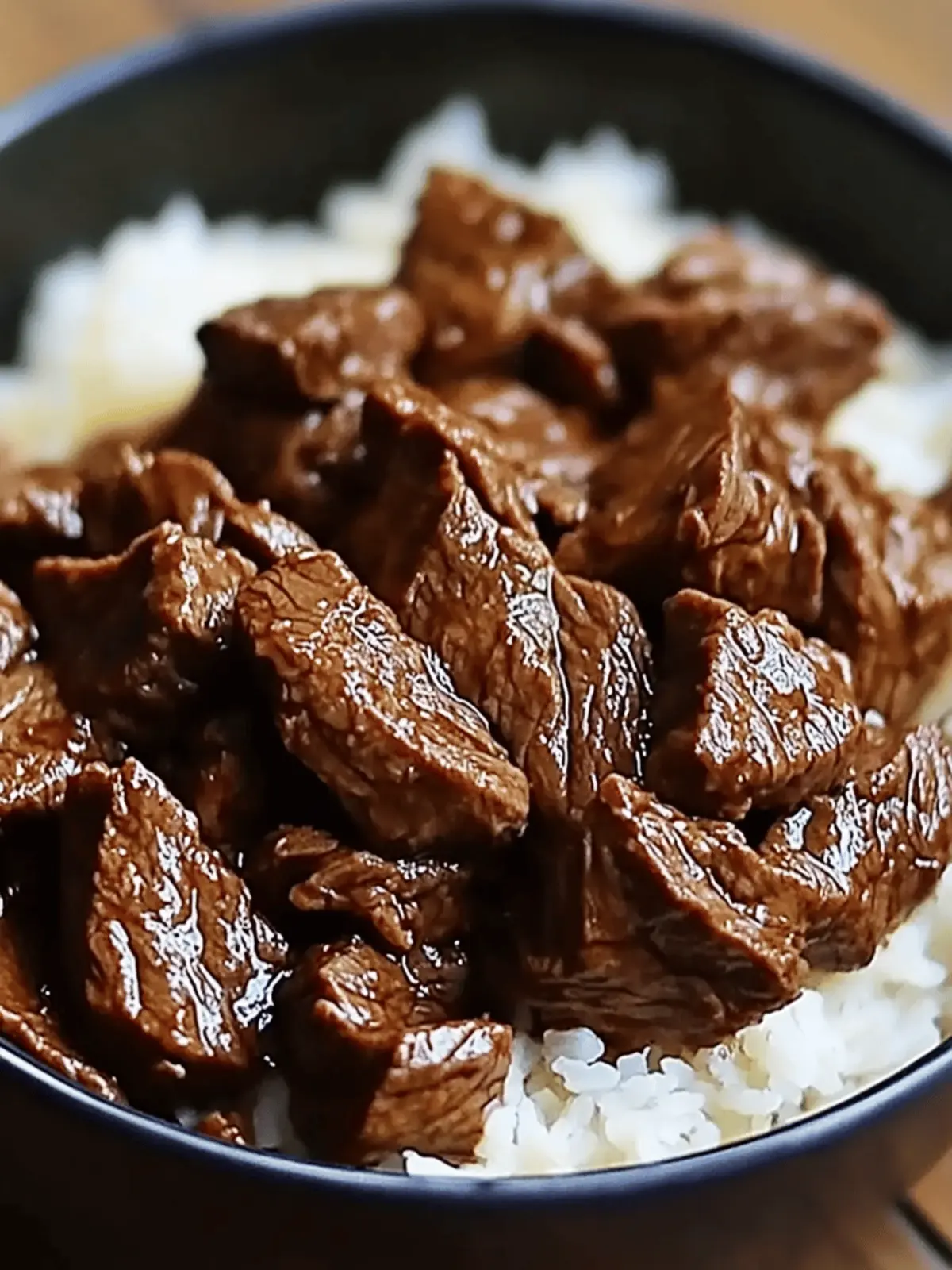
Irresistible Slow Cooker Korean Beef for Ultimate Comfort Food
Ingredients
Equipment
Method
- In your slow cooker, mix together the onion, garlic, ginger, rice wine vinegar, sesame oil, soy sauce, beef stock, brown sugar, and red chili flakes.
- Gently place the chuck beef cubes into the sauce mixture, ensuring every piece is well-coated.
- Cover and set the slow cooker to low. Let it simmer for 8 hours, or until the beef is tender and fragrant.
- In a small bowl, whisk the cornstarch and water until smooth, then stir this mixture back into the slow cooker.
- Increase the heat to high and let it cook for an additional 30 minutes.
- Serve the Slow Cooker Korean Beef hot, garnished with sliced green onions and sesame seeds.

